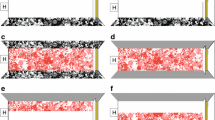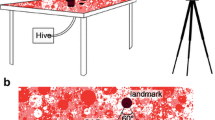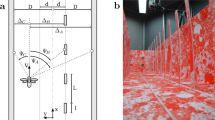Abstract
Flying animals are capable of navigating through environments of different complexity with high precision. To control their flight when negotiating narrow tunnels, bees and birds use the magnitude of apparent image motion (known as optic flow) generated by the walls. In their natural habitat, however, these animals would encounter both cluttered and open environments. Here, we investigate how large changes in the proximity of nearby surfaces affect optic flow-based flight control strategies. We trained bumblebees to fly along a flight and recorded how the distance between the walls—from 60 cm to 240 cm—affected their flight control. Our results reveal that, as tunnel width increases, both lateral position and ground speed become increasingly variable. We also find that optic flow information from the ground has an increasing influence on flight control, suggesting that bumblebees measure optic flow flexibly over a large lateral and ventral field of view, depending on where the highest magnitude of optic flow occurs. A consequence of this strategy is that, when flying in narrow spaces, bumblebees use optic flow information from the nearby obstacles to control flight, while in more open spaces they rely primarily on optic flow cues from the ground.



Similar content being viewed by others
Abbreviations
- TOF:
-
Translational optic flow
References
Baird E, Dacke M (2012) Visual flight control in naturalistic and artificial environments. J Comp Physiol A 198:869–876
Baird E, Srinivasan MV, Zhang SW, Cowling A (2005) Visual control of flight speed in honeybees. J Exp Biol 208:3895–3905
Baird E, Srinivasan MV, Zhang SW, Cowling A (2006) Visual control of flight speed and height in the honeybee. Lect Notes Comput Sci 2095:40–51
Baird E, Kornfeldt T, Dacke M (2010) Minimum viewing angle for visually guided ground speed control in bumblebees. J Exp Biol 213:1625–1632
Baird E, Kreiss E, Wcislo W, Warrant E, Dacke M (2011) Nocturnal insects use optic flow for flight control. Biol Lett 7:499–501
Barron A, Srinivasan MV (2006) Visual regulation of ground speed and headwind compensation in freely flying honey bees (Apis mellifera L.). J Exp Biol 209:978–984
Bhagavatula PS, Claudianos C, Ibbotson MR, Srinivasan MV (2011) Optic flow cues guide flight in birds. Curr Biol 21:1794–1799
Collett TS (2002) Insect vision: controlling actions through optic flow. Curr Biol 12:R615–R617
David CT (1982) Compensation for height in the control of groundspeed by Drosophila in a new, ‘barber’s pole’ wind tunnel. J Comp Physiol A 147:485–493
Dyhr JP, Higgins CM (2010) The spatial frequency tuning of optic-flow-dependent behaviors in the bumblebee Bombus impatiens. J Exp Biol 213:1643–1650
Fry SN, Rohrseitz N, Straw AD, Dickinson MH (2009) Visual control of flight speed in Drosophila melanogaster. J Exp Biol 212:1120–1130
Gibson JJ (1950) The perception of the visual world. Houghton Mifflin, Boston
Gibson JJ (1979) The ecological approach to visual perception. Houghton Mifflin, Boston
Kern R, Boeddeker N, Dittmar L, Egelhaaf M (2012) Blowfly flight characteristics are shaped by environmental features and controlled by optic flow information. J Exp Biol 215:2501–2514
Kirchner WH, Srinivasan MV (1989) Freely flying honeybees use image motion to estimate object distance. Naturwissenschaften 76:281–282
Koenderink JJ (1986) Optic flow. Vision Res 26:161–179
Lappe M (2000) Neuronal processing of optic flow. Academic Press, San Diego
Lee AB, Mumford D, Huang J (2001) Occlusion models for natural images: a statistical study of a scale-invariant dead leaves model. Int J Comput Vis 41:35–59
Linander N, Dacke M, Baird E (2015) Bumblebees measure optic flow for position and speed control flexibly within the frontal visual field. J Exp Biol 218:1051–1059
Lindemann J (2005) Visual navigation of a virtual blowfly. Ph.D. Thesis, Universität Bielefeld, Germany. Available: http://pub.uni-bielefeld.de/publication/2304410. Accessed 20 Nov 2015
Portelli G, Ruffier F, Franceschini N (2010) Honeybees change their height to restore their optic flow. J Comp Physiol A 196:307–313
Portelli G, Ruffier F, Roubieu FL, Franceschini N (2011) Honeybees’ speed depends on dorsal as well as lateral, ventral and frontal optic flows. PLoS One 6:e19486
Schiffer I, Srinivasan MV (2014) Direct evidence for vision-based control of flight speed in budgerigars. Sci Rep. 5:10992
Serres JR, Masson GP, Ruffier F, Franceschini N (2008a) A bee in the corridor: centering and wall-following. Naturwissenschaften 95:1181–1187
Serres JR, Dray D, Ruffier F, Franceschini N (2008b) A vision-based autopilot for a miniature air vehicle: joint speed control and lateral obstacle avoidance. Auton Robot 25:103–122
Srinivasan MV, Lehrer M, Kirchner WH, Zhang SW (1991) Range perception through apparent image speed in freely flying honeybees. Vis Neurosci 6:519–535
Srinivasan MV, Zhang SW, Lehrer M, Collett T (1996) Honeybee navigation en route to the goal: visual flight control and odometry. J Exp Biol 199:237–244
Acknowledgments
We would like to thank Eva Landgren for contribution to the data collection, and Lana Khaldy for helping with the data analysis.
Author information
Authors and Affiliations
Corresponding author
Additional information
E. Baird and M. Dacke contributed equally to this work.
Rights and permissions
About this article
Cite this article
Linander, N., Baird, E. & Dacke, M. Bumblebee flight performance in environments of different proximity. J Comp Physiol A 202, 97–103 (2016). https://doi.org/10.1007/s00359-015-1055-y
Received:
Revised:
Accepted:
Published:
Issue Date:
DOI: https://doi.org/10.1007/s00359-015-1055-y




